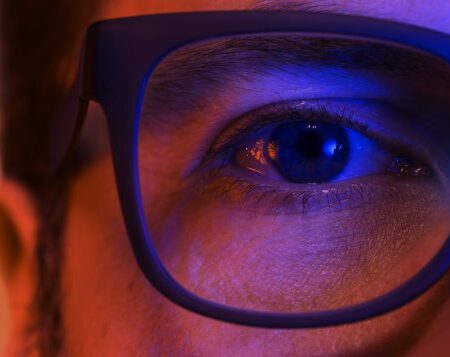Sunglasses by day, blue light glasses at night. While they won’t block annoying texts and spammy push notifications, lenses that filter blue light could help prevent your phone and other screens from keeping you awake at night and disrupting your sleep.
Early bird or night owl? Either way, you probably reach for some help fighting the darkness, whether it’s your morning coffee or that second Red Bull of the evening. The morning crowd has it easier: within an hour or two, the sun is up and the body’s chemistry gets us ready for the day ahead. The wannabe nocturnal ones, on the other hand? They’re going up against a lot of biology and physics.
Light doesn’t just wake us up in the morning. It keeps us awake – one slice of the spectrum, in particular. (psst it’s the blue one)
While they may not be perfect, here’s the science behind why blue light glasses can help you sleep better.
We do more than just “see” blue light
Blue light is on the shorter wavelength end of the visible light spectrum: 450-495 nanometers, where the entire visible spectrum ranges from 400-700 nm. While we can obviously see blue light – it’s in the “visible spectrum,” after all, and most of us have seen various forms of blue light – it’s actually a non-visual aspect of blue light that plays into our sleep-wake cycle.
Wait, what? A blue light that we can’t see is messing with our sleep-wake cycle? OK, let’s do some quick anatomy to go with the physics.

Vision starts with the light that comes into our eyes, passes through the lenses and projects onto the retinas. The retinas have the rods and cones that are the basic processing units of vision: they kick off the chain of neuronal signals that enable the brain to process – and us to see – color, contours and motion.
But the rods and cones have a partner on the retina: intrinsically photosensitive retinal ganglion cells (ipRGCs). The ipRGCs are photoreceptors, like the rods and cones. But unlike those more well-known receptors, when ipRGCs react to light they do not send signals to the visual cortex. That is, they, process light but they do not contribute to vision. Instead, the ipRGCs communicate with the parts of the brain that do things like control how our pupils expand and contract in response to light levels; and the parts that control our circadian rhythms. So to sum it up, ipRGCs are the receptors that sneakily affect our brains chemistry that we cannot visually see as light.
These non-visual photoreceptors send signals that ultimately reduce the amount of melatonin the brain releases. If you know any overnight workers who pop melatonin supplements to finish their day as regularly as they down caffeine to start it, you might see where this is going. Melatonin is how the body powers down in preparation for sleep, and gets the body ready for all the wonderful restorative things the body does while we’re sleeping. Melatonin is a big part of how we’re able to gently wind down, sink into bed and fall into a nice deep sleep at the end of a hard day. Or maybe melatonin just takes the edge off enough that we can get a few fitful hours in before the alarm goes off and we do it all over again. Whatever your sleep is like, it starts with melatonin ok? Good.
Restful sleep requires some prep work
Improving our sleep, then, entails setting the right conditions a few hours before we go to bed. One of those conditions is reducing the amount of light we’re exposed to. Fortunately, that doesn’t mean sitting in the dark from 8pm onwards. Remember, it’s not “Big Light” that’s the issue: it’s blue light. Unfortunately, a lot of what we do during those evening hours is blue light intensive.
Just about every screen we look at is a mini-sun of blue light. The soft white glow of your phone, tablet and computer screen (laptop or desktop) is actually a high concentration of blue light. Our TVs – whether we use them for nightly streaming or gaming – put out a lot of blue light, too.
No, this is not an evil plot to deprive us of sleep.

It’s actually just an unfortunate side effect of the engineering that makes those devices bright, low weight, high res and energy efficient. The most desirable characteristics of white light from electronic devices come about from making intense use of blue light in the range of 470-490nm.
We’ll give you one guess what range of light those melatonin-suppressing ipRGCs are most sensitive, too. Yeah, 470-480 nm.
Honestly, not an evil plot. And if it was, it would be a pretty lame one. Think about it: if we know the range of light that does the thing we don’t want to happen, all we need to do is get rid of that light somehow, right??
Blue light lenses put your eyes and brain in “night mode”
Most operating systems now come with a “night mode” option that gives you a black background instead of a white background, reducing the amount of blue light the device emits. Some people with all-screen all-the-time jobs keep their screens on night mode throughout the day.
Blue light lenses – also called amber glasses – are also increasingly popular. These are lenses (prescription if you need one, non-prescription if you don’t) in normal eyeglass frames where the lenses have a coating that filters out light in the blue range. LensDirect’s BluDefend lenses actually embed the filter in the lens itself, which has the added benefit of making the lens much more clear than other blue light lenses out there. Whereas most blue light glasses look a bit, well, blue, our lenses just look like clear glass.

But we are not saying that blue light glasses are perfect. So far, the scientific research is a bit mixed on the effects that wearing blue light glasses have on sleep. But we still advocate for blue light glasses, because it only makes sense that if we want to improve melatonin production, we can block out a certain wave length of light (blue light), that science has found effects our sleep cycle.
It certainly stands to reason that if those particular photoreceptors suppress melatonin and respond to a specific band of light, then by filtering out that band of light the melatonin will flow freely in response to normal circadian rhythms.
But what if the blue light from your screen is just outside the range of light your blue light lenses filter? What if you’re diligently wearing your blue light lenses, you take them off to play with your dog, and then you forget to put them back on before taking a quick scroll through Insta? Did you just derail the experiment? How many hours before going to sleep should you wear them? And maybe you did everything “right” with your eyewear and screen time, but you’re still completely fired up from your pickleball conquests earlier in the day and you struggle to fall asleep.
Science… it ain’t easy.
TLDR, so do blue light glasses help with sleep?
The short answer, yes, based on the science and logic we discussed above, but it’s just one thing you can do to provide yourself more restful sleep.
There are a lot of things we can all do to sleep better. Managing our screen time is a big one, and blue light lenses could be part of that. And with a starting price of $30, you’ll still be able to buy all the coffee and Red Bull you want (and maybe not need).
Our best advice is honestly to try it out for yourself see if it makes a difference, but try to do more than just wear them if you want better sleep. Again, they’re not perfect but we hope you took away the science and logic behind them. For those who decide to take the leap after reading this, at least when your friends tell you, “you know those things don’t work right?”, you can remember this blog post, raise your index finger in the air and say, “yeah, but baisht on my scientific calculations it should work”.

Subscribe to our email newsletter to get the latest posts delivered right to your email.

